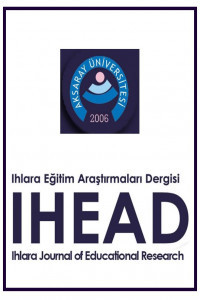PROSPECTIVE MIDDLE SCHOOL MATHEMATICS TEACHERS’ USE OF PARAMETERS IN EXPLAINING GEOMETRIC TRANSFORMATIONS
Parameters of geometric transformations, prospective teachers, reflection line, angle of rotation, center of rotation
PROSPECTIVE MIDDLE SCHOOL MATHEMATICS TEACHERS’ USE OF PARAMETERS IN EXPLAINING GEOMETRIC TRANSFORMATIONS
Parameters of geometric transformations, prospective teachers, reflection line, angle of rotation, center of rotation,
___
- Battista, M. T. (2001). Shape makers: A computer environment that engenders students’ construction of geometric ideas and reasoning. Computers in Schools, 17, 105-120.
- Clements, D. H., & Battista, M. T. (1992). Geometry and spatial understanding. In D. A. Grouws (Ed.), Handbook of research on mathematics teaching and learning (pp. 420-465). New York: McMillan Publishing Company.
- Edwards, L. D. (1997). Exploring the territory before proof: Students’ generalizations in a computer microworld for transformation geometry. International Journal of Computers for Mathematical Learning, 2, 187-215.
- Farmer, D. W. (1996). Groups and symmetry: A guide to discovering mathematics. Providence: American Mathematical Society.
- Harper, S. (2003). Enhancing elementary pre-service teachers’ knowledge of geometric transformations through the use of dynamic geometry computer software. In C. Crawford, N. Davis, J. Price, R. Weber, & D. Willis (Eds.), Proceedings of Society for Information Technology & Teacher Education International Conference (pp. 2909-2916). Chesapeake, VA: Association for the Advancement of Computing in Education.
- Hegarty, M., & Waller, D. (2005). Individual differences in spatial abilities. In P. Shah & A. Miyake (Eds.), The Cambridge handbook of visuospatial thinking (pp. 121–169). New York: Cambridge University Press.
- Hollebrands, K. F. (2004). High school students’ intuitive understandings of geometric transformations. Mathematics Teacher, 97, 207-214.
- Leong Y. H., & Lim-Teo S. K. (2003). Effects of Geometer’s Sketchpad on spatial ability and achievement in transformation geometry among secondary two students in Singapore. The Mathematics Educator, 7(1), 32-48.
- National Council of Teachers of Mathematics. (2000). Principles and standards for school mathematics. Reston, VA: NCTM.
- Portnoy, N., Grundmeier, T. A., & Graham, J. G. (2006). Students’ understanding of mathematical objects in the context of transformational geometry: Implications for constructing and understanding proofs. Journal of Mathematical Behavior, 25, 196-207.
- Ramful, A., Ho, S. Y., & Lowrie, T. (2015). Visual and analytical strategies in spatial visualization: Perspectives from bilateral symmetry and reflection. Mathematics Education Research Journal, 27, 443-470.
- Thaqi, X., Gimenez, J., & Rosich, N. (2011). Geometrical transformation as viewed by prospective teachers. In Pytlak, M., Rowland, T., & Swoboda, E. (Eds.), Proceedings of the Seventh Congress of the European Society for Research in Mathematics Education (pp. 578-587). Univerity of Rszeszów, Poland.
- Van de Walle, J. A., Karp, K. S., & Williams, J. M. B. (2016). Elementary and middle school mathematics: Teaching developmentally (9th ed.). New York, NY: Pearson Education.
- Yanık, H. B. (2011). Prospective middle school mathematics teachers’ preconceptions of geometric translations. Educational Studies in Mathematics, 78(2), 231-260.
- Yanık, H. B. (2014). Middle-school students’ concept images of geometric translations. The Journal of Mathematical Behavior, 36(1), 33-50.
- ISSN: 2528-9624
- Yayın Aralığı: Yılda 2 Sayı
- Başlangıç: 2016
- Yayıncı: Aksaray Üniversitesi
“MİKROORGANİZMA VE HİJYEN” KAVRAMLARINA YÖNELİK GELİŞİMSEL BİR ARAŞTIRMA
Elvan İNCE AKA, Mehmet YILMAZ, Ferhat KARAKAYA
OKUL ÖNCESİ DÖNEM ÇOCUKLARININ OKUL ALGILARININ BELİRLENMESİ
Döndü Neslihan BAY, Şuheda GEYİK, Yadigar Melihan ÇALIŞKAN
EĞİTİMDE SINIF OTURMA DÜZENİNİN ÖNEMİ
SINIF ÖĞRETMENİ ADAYLARININ FEN BİLİMLERİ EĞİTİMİNE YÖNELİK GÖRÜŞLERİNİN BELİRLENMESİ
